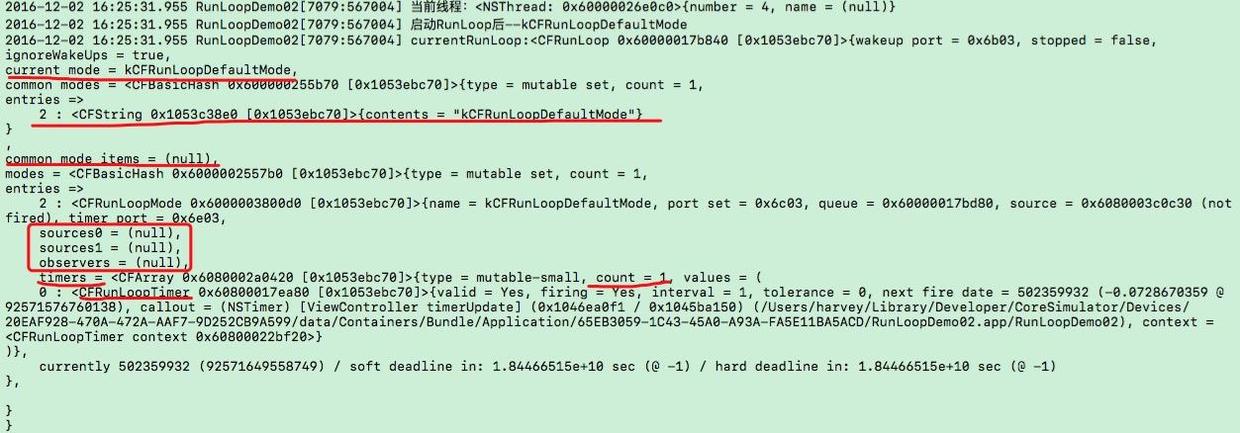RunLoop 總結:RunLoop的應用場景(二)
上一篇講了使用RunLoop保證子線程的長時間存活,而不是執行完任務後就立刻銷毀的應用場景。這一篇就講述一下RunLoop如何保證NSTimer在視圖滑動時,依然能正常運轉。
參考資料
好的書籍都是值得反復看的,那好的文章,好的資料也值得我們反復看。我們在不同的階段來相同的文章或資料或書籍都能有不同的收獲,那它就是好文章,好書籍,好資料。
關於iOS 中的RunLoop資料非常的少,以下資料都是非常好的。
CF框架源碼(這是一份很重要的源碼,可以看到CF框架的每一次迭代,我們可以下載最新的版本來分析,或與以下文章對比學習。目前最新的是CF-1153.18.tar.gz)
RunLoop官方文檔(學習iOS的任何技術,官方文檔都是入門或深入的極好手冊;我們也可以在Xcode--->Help--->Docementation and API Reference --->搜索RunLoop---> Guides(59)--->《Threading Programming Guide:Run Loops》這篇即是)
深入理解RunLoop(不要看到右邊滾動條很長,其實文章占篇幅2/5左右,下面有很多的評論,可見這篇文章的火熱)
RunLoop個人小結 (這是一篇總結的很通俗容易理解的文章)
sunnyxx線下分享RunLoop(這是一份關於線下分享與討論RunLoop的視頻,備用地址:https://pan.baidu.com/s/1pLm4Vf9)
iPhonedevwiki中的CFRunLoop(commonModes中其實包含了三種Mode,我們通常知道兩種,還有一種是啥,你知道麼?)
維基百科中的Event loop(可以看看這篇文章了解一下事件循環)
使用場景
1.我們經常會在應用中看到tableView 的header 上是一個橫向ScrollView,一般我們使用NSTimer,每隔幾秒切換一張圖片。可是當我們滑動tableView的時候,頂部的scollView並不會切換圖片,這可怎麼辦呢?
2.界面上除了有tableView,還有顯示倒計時的Label,當我們在滑動tableView時,倒計時就停止了,這又該怎麼辦呢?
場景中的代碼實現
我們的定時器Timer是怎麼寫的呢?
一般的做法是,在主線程(可能是某控制器的viewDidLoad方法)中,創建Timer。
可能會有兩種寫法,但是都有上面的問題,下面先看下Timer的兩種寫法:
// 第一種寫法NSTimer *timer = [NSTimer timerWithTimeInterval:1.0 target:self selector:@selector(timerUpdate) userInfo:nil repeats:YES]; [[NSRunLoop currentRunLoop] addTimer:timer forMode:NSDefaultRunLoopMode]; [timer fire]; // 第二種寫法NSTimer *timer = [NSTimer scheduledTimerWithTimeInterval:1.0 target:self selector:@selector(timerUpdate) userInfo:nil repeats:YES]; [timer fire];
上面的兩種寫法其實是等價的。第二種寫法,默認也是將timer添加到NSDefaultRunLoopMode下的。
要驗證這一結論,我們只需要在timerUpdate方法中,將當前runLoop的currentMode打印出來即可。
- (void)timerUpdate
{
NSLog(@"當前線程:%@",[NSThread currentThread]);
NSLog(@"啟動RunLoop後--%@",[NSRunLoop currentRunLoop].currentMode);
// NSLog(@"currentRunLoop:%@",[NSRunLoop currentRunLoop]);
dispatch_async(dispatch_get_main_queue(), ^{
self.count ++;
NSString *timerText = [NSString stringWithFormat:@"計時器:%ld",self.count];
self.timerLabel.text = timerText;
});
}
// 控制台輸出結果:
2016-12-02 15:33:57.829 RunLoopDemo02[6698:541533] 當前線程:{number = 1, name = main}
2016-12-02 15:33:57.829 RunLoopDemo02[6698:541533] 啟動RunLoop後--kCFRunLoopDefaultMode 然後,我們在滑動tableView的時候timerUpdate方法,並不會調用。
原因是啥呢?
原因是當我們滑動scrollView時,主線程的RunLoop 會切換到UITrackingRunLoopMode這個Mode,執行的也是UITrackingRunLoopMode下的任務(Mode中的item),而timer 是添加在NSDefaultRunLoopMode下的,所以timer任務並不會執行,只有當UITrackingRunLoopMode的任務執行完畢,runloop切換到NSDefaultRunLoopMode後,才會繼續執行timer。
要如何解決這一問題呢?
解決方法很簡單,我們只需要在添加timer 時,將mode 設置為NSRunLoopCommonModes即可。
- (void)timerTest
{
// 第一種寫法
NSTimer *timer = [NSTimer timerWithTimeInterval:1.0 target:self selector:@selector(timerUpdate) userInfo:nil repeats:YES];
[[NSRunLoop currentRunLoop] addTimer:timer forMode:NSRunLoopCommonModes];
[timer fire];
// 第二種寫法,因為是固定添加到defaultMode中,就不要用了
}從RunLoop官方文檔和 iPhonedevwiki中的CFRunLoop可以看出,NSRunLoopCommonModes並不是一種Mode,而是一種特殊的標記,包含三種mode(kCFRunLoopDefaultMode、NSTaskDeathCheckMode、UITrackingRunLoopMode),添加到NSRunLoopCommonModes中的還沒有執行的任務,會在mode切換時,再次添加到當前的mode中,這樣就能保證不管當前runloop切換到哪一個mode,任務都能正常執行。並且被添加到NSRunLoopCommonModes中的任務會存儲在runloop 的commonModeItems中。
其他一些關於timer的坑
我們在子線程中使用timer,也可以解決上面的問題,但是需要注意的是把timer加入到當前runloop後,必須讓runloop 運行起來,否則timer僅執行一次。
示例代碼:
//首先是創建一個子線程
- (void)createThread
{
NSThread *subThread = [[NSThread alloc] initWithTarget:self selector:@selector(timerTest) object:nil];
[subThread start];
self.subThread = subThread;
}
// 創建timer,並添加到runloop的mode中
- (void)timerTest
{
NSRunLoop *runLoop = [NSRunLoop currentRunLoop];
NSLog(@"啟動RunLoop前--%@",runLoop.currentMode);
NSLog(@"currentRunLoop:%@",[NSRunLoop currentRunLoop]);
// 第一種寫法,改正前
// NSTimer *timer = [NSTimer timerWithTimeInterval:1.0 target:self selector:@selector(timerUpdate) userInfo:nil repeats:YES];
// [[NSRunLoop currentRunLoop] addTimer:timer forMode:NSDefaultRunLoopMode];
// [timer fire];
// 第二種寫法
NSTimer *timer = [NSTimer scheduledTimerWithTimeInterval:1.0 target:self selector:@selector(timerUpdate) userInfo:nil repeats:YES];
[timer fire];
[[NSRunLoop currentRunLoop] run];
}
//更新label
- (void)timerUpdate
{
NSLog(@"當前線程:%@",[NSThread currentThread]);
NSLog(@"啟動RunLoop後--%@",[NSRunLoop currentRunLoop].currentMode);
NSLog(@"currentRunLoop:%@",[NSRunLoop currentRunLoop]);
dispatch_async(dispatch_get_main_queue(), ^{
self.count ++;
NSString *timerText = [NSString stringWithFormat:@"計時器:%ld",self.count];
self.timerLabel.text = timerText;
});
}添加timer 前的控制台輸出:

添加timer前的runloop
添加timer後的控制台輸出:

添加timer後的runloop
從控制台輸出可以看出,timer確實被添加到NSDefaultRunLoopMode中了。可是添加到子線程中的NSDefaultRunLoopMode裡,無論如何滾動,timer都能夠很正常的運轉。這又是為啥呢?
這就是多線程與runloop的關系了,每一個線程都有一個與之關聯的RunLoop,而每一個RunLoop可能會有多個Mode。CPU會在多個線程間切換來執行任務,呈現出多個線程同時執行的效果。執行的任務其實就是RunLoop去各個Mode裡執行各個item。因為RunLoop是獨立的兩個,相互不會影響,所以在子線程添加timer,滑動視圖時,timer能正常運行。
總結
1、如果是在主線程中運行timer,想要timer在某界面有視圖滾動時,依然能正常運轉,那麼將timer添加到RunLoop中時,就需要設置mode 為NSRunLoopCommonModes。
2、如果是在子線程中運行timer,那麼將timer添加到RunLoop中後,Mode設置為NSDefaultRunLoopMode或NSRunLoopCommonModes均可,但是需要保證RunLoop在運行,且其中有任務。
文中的示例代碼都來自:RunLoopDemos中的RunLoopDemo02
- 上一頁:iOS時間問題
- 下一頁:布局萬花筒:UIColletionview
- iOS Runntime 靜態添加類辦法並挪用-class_addMethod
- iOS應用runtime修正文本框(TextField)的占位文字色彩
- 總結iOS中runtime的應用
- IOS UI進修教程之辨別NSBundle和NSURL(讀取文件、寫入文件)
- Unity3d宣布IOS9運用時湧現中文亂碼的處理辦法
- iOS開辟之詳談屬性設置readwrite、readonly、retain、copy、assign、nonatomic
- Unity3d發布IOS9使用時呈現中文亂碼的處理辦法
- iOS 切換到MRC環境下打印 retainCount 一直是-1或許一長串證書
- iOS 功能優化:Instruments 工具的救命三招
- This iPhone 6 is running iOS 10.2 (14C92), which may not be supported by this version of Xcode.
- unity3d導出到IOS順序下 集成unity3dAR功用
- unity工程導入到iOS項目
- iOS運用UICountingLabel完成數字變化的動畫效果
- 運用runtime 完成weex 跳轉原生頁面
- iOS之解體處置:This application is modifying the autolayout engine from a background thread




